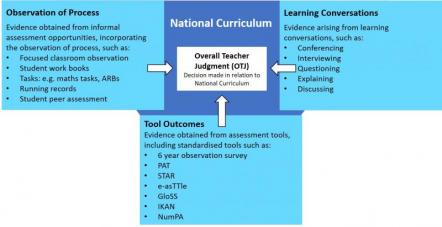You are here:
- Home »
- Overall teacher judgment »
- Making an overall teacher judgment
Making an overall teacher judgment
We are preparing to close this site soon as this content has now moved to Tāhūrangi.
Tāhūrangi is the new online curriculum hub for Te Tāhuhu o te Mātauranga | Ministry of Education.
This page gives guidance on the range and types of information used in making an overall teacher judgment, guidance on using assessment tools, and some links to practical examples of making overall teacher judgments.
An overall teacher judgment (OTJ) involves drawing on and applying the evidence gathered up to a particular point in time, in order to make an overall judgment about a student’s progress and achievement.
No single source of information can accurately summarise a student’s achievement or progress. A range of approaches is necessary in order to compile a comprehensive picture of the areas of progress, areas requiring attention, and what a student’s unique progress looks like. Using a range of approaches also allows the student to participate throughout the assessment process, building their assessment capability. Because of this, to assess a student in relation to National Curriculum levels, teachers need to bring together a range of evidence in order to form an overall teacher judgment.
Overall teacher judgments of achievement and progress involve combining information from a variety of sources, using a range of approaches. Evidence may be gathered in the following three ways:
- Observing the process a student uses to complete a learning task.
- Conversing with the student to find out what they know, understand and can do.
- Gathering results from formal assessments, including standardised tools.
This gathering of information from a range of sources increases the dependability of the OTJ. The diagram above explains in more detail.
Any point of the triangle provides an approach to gathering evidence of learning. The use of a range of evidence accumulated over the year builds dependability in progress and achievement decisions. An OTJ can be made when the teacher reviews all of the evidence, rather than relying on a single source of evidence.
When using an assessment tool to back up a teacher judgment
When using assessment tools teachers should:
- understand the purpose of the assessment
- know the curriculum content well enough to clearly understand what is being assessed and that it is being assessed appropriately
- consider the difficulty of the assessment so that it fairly matches the level of the student
- know how to select an assessment tool, administer it and interpret the outcomes
- support students to understand what is being assessed and why
- know how to respond to assessment outcomes in a way that benefits student learning.
Visit the assessment tool selector to review a range of assessment tools.
School exampleHere is an example of how evidence is collected from multiple sources in reading. You can see clearly from the example that students are fully involved in the learning and assessment process. |


